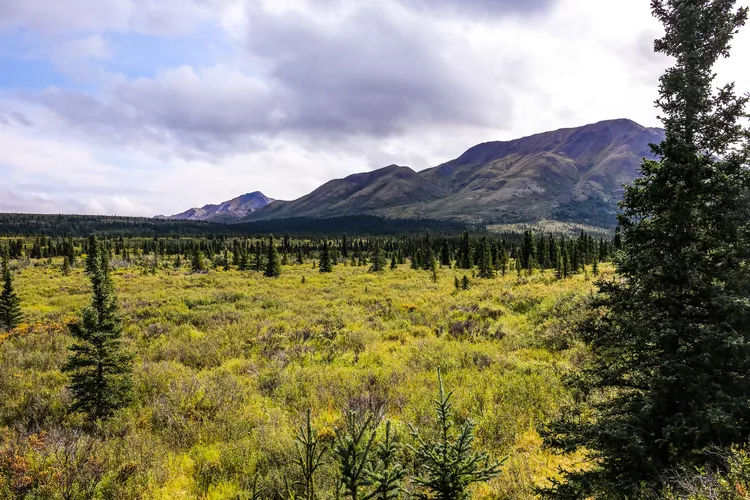Summary of Weather Conditions in Denali National Park
Most visitors come to Denali National Park in Alaska during the summer when daytime temperatures usually range from the 50s to 60s degrees Fahrenheit. However, temperatures can occasionally climb to 90 degrees Fahrenheit (32 degrees Celsius). The nights tend to cool down 10 to 20 degrees, leading to an average daily temperature range of about 22 degrees in the summer.
Here are the averages by month so you can better understand the conditions to expect. It is important to note that the length of day and night varies significantly compared to the lower 48 states. Notably, nights are much longer during winter while the darkness period is brief in the summer.
| Denali National Park Monthly Weather Statistics | |||||
|---|---|---|---|---|---|
|
Month |
Average high |
Average low | Average rainfall | Average snowfall |
Average Length of Day |
| January | 11 F (-12 C) | -5 F (-21 C) | 0.6 inches | 9.0 inches | 6.8 hours |
| February | 17 F (-8 C) | -2 F (-19 C) | 0.5 inches | 8.4 inches | 9.6 hours |
| March | 26 F (-3 C) | 1.2 F (-17 C) | 0.4 inches | 6.8 inches | 12.7 hours |
| April | 39 F (4 C) | 16 F (-9 C) | 0.4 inches | 6.1 inches | 16.2 hours |
| May | 54 F (12 C) | 31 F (-1 C) | 0.9 inches | 3.1 inches | 19.9 hours |
| June | 65 F (18 C) | 41 F (5 C) | 2.2 inches | 0.1 inches | 22.4 hours |
| July | 67 F (19 C) | 45 F (7 C) | 3.2 inches | 0 inches | 20.5 hours |
| August | 61 F (16 C) | 40 F (4 C) | 2.7 inches | 0 inches | 17.2 hours |
| September | 50 F (10 C) | 31 F (-1 C) | 1.7 inches | 4.7 inches | 13.7 hours |
| October | 32 F (0 C) | 14 F (-10 C) | 0.8 inches | 9.9 inches | 10.5 hours |
| November | 17 F (-8 C) | 1 F (-17 C) | 0.8 inches | 13.2 inches | 7.5 hours |
| December | 15 F (-9 C) | -1 F (-18 C) | 0.9 inches | 15.4 inches | 5.7 hours |
When visiting, it is wise to dress in layers—this includes a base layer, an insulating layer like a vest or wool shirt, and a waterproof and windproof jacket. These layers provide comfort by allowing you to adjust your clothing according to the weather throughout the day.
Temperature Extremes at Denali National Park
Extreme temperature fluctuations are particularly common in winter months, where one can experience as much as a 68-degree Fahrenheit change in a single day. Furthermore, the park’s north side typically experiences drier conditions and larger temperature swings compared to the south side. Essentially, it is colder during winter and hotter in summer on the north side.
Climbing Weather at Denali National Park
Weather conditions and temperatures also vary significantly with altitude. Therefore, if climbing is on your agenda, it is advisable to consult the mountain weather observations available on the National Park Service’s website. This resource provides daily weather observations from April to July for the 7,200-foot camp and insights from climbers who have reached the 14,200-foot camp, including information on sky conditions, temperature, wind speed and direction, precipitation, and barometric pressure.
Altitude Variations
Denali National Park boasts a considerable altitude range, from the lowest point at the Yentna River, which is only 223 feet above sea level. As you ascend or descend, you may notice weather changes, such as rain turning to snow, and substantial temperature variations, even at different altitudes. Additionally, wind speed and cloud cover can also differ significantly.
The Denali Visitor Center sits at 1,746 feet above sea level, the Eielson Visitor Center at 3,733 feet, Polychrome Overlook at 3,700 feet, Wonder Lake Campground at 2,055 feet, and the summit of Mount Denali reaches 20,310 feet, making it the highest peak in North America.
Webcams to View the Weather
During the summer, visitors to Denali often hope to glimpse the majestic mountain through the clouds, but most leave disappointed. To assist with this, the National Park Service operates several webcams that provide live views of current conditions. These include the Alpine Tundra webcam situated on the shoulder of Mount Healy and the visibility webcam at Wonder Lake.




